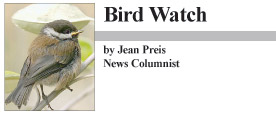Important News
 It has been raining off and on for days, a steady, soaking rain that nurtures new spring growth. Rain has even penetrated the thick layer of forest duff, the multi-year accumulation of fallen leaves, pine needles, and branches that carpets the Maine woods.
It has been raining off and on for days, a steady, soaking rain that nurtures new spring growth. Rain has even penetrated the thick layer of forest duff, the multi-year accumulation of fallen leaves, pine needles, and branches that carpets the Maine woods.
It is still early in the morning, and we are seated in front of the living room window, sipping hot tea and munching raisin toast, and looking out over the lush backyard and the cove, where raindrops dimple the surface of the soft gray lake. Although daylight is already well underway, on this drizzly morning the light is muted. Mist draws a curtain over the far shore, making the trees look dim and distant. The quantity of falling water has brought up the level of the lake, so each morning we compare the rocks that are showing, or not showing, with those that were showing, or not showing, the previous day. Today, only the largest rocks still break the surface of the water. Several smaller ones have disappeared since yesterday.
When my husband softly announces “duck alert,†to let me know he sees a duck swimming into view, I quickly put my tea mug down on the table and reach for the binoculars that are tucked into the chair beside me. Two fairly small ducks are swimming into the quiet corner of the cove, and their appearance is so distinctive, riding high in the water, that even before we see them through the binoculars we know they are wood ducks. They clamber up onto a small rock, barely large enough to hold the two of them, and stand facing in opposite directions while they preen their feathers. The female is brown, with a teardrop shaped patch of white feathers around her eye. The male wears a long handsome crest, and his feathers are multicolored: chestnut, dark green, white, and rich tan, accented by bright white streaks. He is as magnificent as his mate is subtle. Our admiration is short-lived, though. After preening on the small rock for a few minutes, the ducks take off and disappear over the lake.
Putting down the binoculars and picking up our tea mugs, we chat about the upcoming day, the beauty of the scene out the window, and a story we heard on the news last evening. Conversation comes to an abrupt halt when my husband once again murmurs, “duck alert.†Two new ducks, hooded mergansers, have slid into the quiet corner of the cove. Like the wood ducks they are relatively small, and have crests, but this female’s bushy crest sticks out behind her head, and the male’s white crest bordered with black appears quite rounded. The male’s back is black, his sides are rust colored, and his white breast has two wide diagonal black bars down each side. He is strikingly handsome. The pair floats nearly motionless on the rain-dimpled water, giving us time to pass the binoculars back and forth, and to comment on how it is possible to distinguish them from the wood ducks just by silhouette and behavior. Like the wood ducks, though, the hooded mergansers stay only a few minutes before taking off.
After they leave, we get out the bird book to refresh our knowledge of both species. Although they are in different families, wood ducks and hooded mergansers are similar in size, only about eighteen inches long, and both nest in tree cavities. Wood ducks, in a group known as perching ducks because they often perch in trees, feed on or near the surface of the water, sometimes tipping their heads down below the surface to reach for food, with tail pointing skyward. They eat a varied diet of crustaceans, seeds, acorns, berries, and other foods. Hooded mergansers dive below the surface to catch fish in their serrated bills, as well as various aquatic invertebrates.
For now, we have forgotten about last evening’s news, and the latest world crisis. The important news is that wood ducks and hooded mergansers have visited our cove on a beautiful rainy day, when the world is new, green, and filled with the hope of a new season.

